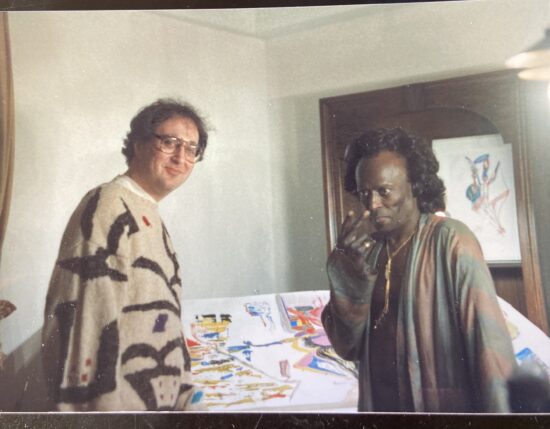Jason Miles isn’t a household name, like many of the artists he’s worked with – from Miles Davis to Luther Vandross, Whitney Houston to Sting, Aretha Franklin to Michael Jackson, George Benson to Grover Washington Jr., Marcus Miller to Michael Brecker, Chaka Khan to Diana Ross, the list goes on. But he deserves a seat at the table. For many of the musical icons who have towered above us over the past five decades, Miles has been there to help lay the foundation, serving as both an architect of sound and a bricklayer of beat.
He made a name for himself during the rise of the synthesizer in the late 1970s and early ’80s, when established musicians were searching for new avenues, and hungry innovators like Miles showed the possibilities of a budding technology that would soon change the recording business. The producer, programmer and keyboardist made a considerable mark in his role as synthesizer programmer for Miles Davis’s post-comeback, late-career standouts Tutu and Amandla. He has amassed a body of work built on a lifetime of undeniable passion and unbelievable friendships.

From the late ’80s through the ’90s and 2000s, Miles became a go-to studio collaborator for heavyweight artists and producers. While he made a living from session work, he continued to prioritize his outings as a leader. A Love Affair: The Music of Ivan Lins (Telarc), a tribute to the acclaimed Brazilian composer, won a Grammy in 2000 for Best Male Pop Vocal Performance (Sting’s vocal on “She Walks This Earth”).
His Kind of New project (Blue Is Paris, Black Magic, Miles to Miles) has featured the likes of Jay Rodriguez, Reggie Washington, Gene Lake, Ingrid Jensen and more. Miles has also undertaken such arranging and production projects as Celebrating the Music of Weather Report (Telarc), To Grover with Love (Q Records/Atlantic), To Grover with Love/Live in Japan (Whaling City Sound) and What’s Going On? Songs of Marvin Gaye (Narada Jazz), buoyed by the stellar musicianship of Chuck Loeb, Greg Philinganes, Will Lee, Victor Bailey, Steve Gadd and many more.
Miles also collaborated with songwriter Kathy Byalick, his wife of 44 years, on a New Age album titled Visionary Path: Guided Journeys for the Mind and Spirit (Prophesy, 2001), featuring narration by Diana Krall, F. Murray Abraham and the dearly missed Roberta Flack.
The Brooklyn-born Miles grew up listening to everything from Wes Montgomery to Jackie Gleason–conducted instrumental albums. As a teen in the mid-to-late ’60s he led his own band at Catskills resorts. After graduating Indiana State University in the early ’70s he made his way back to New York City, soaking up its vibrant club scene, befriending musicians like Joe Zawinul and members of Weather Report while taking piano lessons and teaching himself about electronic instruments, which were still in their infancy.
During those formative years he cut an album, Cosmopolitan (1979), featuring an assortment of prominent musicians including Michael Brecker (tenor sax), Gerry Niewood (alto and soprano sax, flute), Jeff Williams (drums), Badal Roy (tabla), Ricardo Silveira (guitar), Armen Halburian and Henry Castelanos (percussion) and Clarice Taylor (vocals), as well as a 19-year old Marcus Miller on bass.

Miles continued to struggle and find his way until he bumped into Brecker at a sushi restaurant in 1984. The tenor star put him back in touch with Marcus Miller, now also ascending in his career. Miles joined Miller’s band, Jamaica Boys, a stint that led to production work with David Sanborn. In 1986, Miller called Jason to bring his synth to the studio. His services and skills were needed for a much larger project.

After 30 years with Columbia Records, Miles Davis signed with Warner Bros. to work with Miller and legendary producer Tommy LiPuma. Davis was fed up with being neglected by Columbia executives, who were busy devoting their energy to a young Wynton Marsalis and a more traditional jazz sound. At 60, Davis was searching for something new, and Jason Miles was the man for the job.
During the production of the Grammy-winning Tutu, Miles helped give Davis the fresh sound he was looking for, and in his 1989 autobiography, the trumpeter referred to him as a “synthesizer genius.” The two remained friends until Davis’s death in 1991.
Now in his seventh decade of life and residing with Byalick in Lisbon, Portugal, Miles continues to record and perform for appreciative European audiences with his current band, The Lisbon Electric 4Tet. A decade earlier, he’d fallen in love with the city and its flourishing live scene, which includes fans of his own music. In 2022, Jason and Kathy sold their home in upstate New York and headed across the pond. That same year, Miles published his autobiography, The Extraordinary Journey of Jason Miles, and is currently working on a follow-up. One might say that even today, in the words of U2, he still hasn’t found what he’s looking for: his big break. JT
